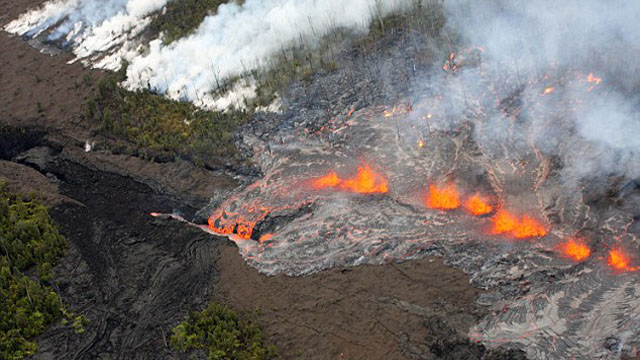Watching the Halema`uma`u Crater

The collapse pit within the Halema`uma`u Crater at Kilauea taken January 7, 2010. Image courtesy of the USGS/HVO.
Eruptions reader Boris Behncke pointed out that things are afoot in the Halema`uma`u Crater at Kilauea. To steal his description: ” the lava lake returned triumphantly to the active pit last night, and now it is filling virtually the entire field of the
Halema’uma’u Overlook webcam.”
Sure enough, checking out the webcam this morning, the field of view is dominated by a lava lake – albeit somewhat crusted over by hardened basalt lava. You can compare the current image with one from a similar vantage point taken ~1 week ago and see how much more lava seems to be filling the crater. You can also see that since 1/13, there has been inflation at Kilauea, which might explain some of this new lava arriving in the crater.
HVO’s latest update (from 1/14/2010) for the summit region:
A churning, spattering lava surface was visible via webcam rising and falling within an opening in the bottom of a 200 m-deep pit inset within the floor of Halema`uma`u Crater; the lava surface, at the peak of the filling cycle, rose slowly so that by this morning, it was above the rim of the opening in the bottom of the deep pit, etc.. Strong glow was visible from the Jaggar Museum Overlook.
This morning, the summit vent gas plume is rising at least 600 m (2,000 ft) before moving to the north. The most recent sulfur dioxide emission rate measurement was 700 tonnes/day on January 12, 2010, significantly above the 2003-2007 average of 140 tonnes/day; new measurements must await the return of moderate trade winds. Very small amounts of mostly ash-sized tephra continue to be carried out by ascending gases; this morning’s collection again contained mostly fresh spatter bits.
The summit tiltmeter network continued to record DI inflation already exceeding the amount of DI deflation and still increasing. The GPS network, which is less sensitive than the tiltmeter network, recorded about 1 cm of contraction over the last 3 months and switched to extension and contraction mimicking the tilt in early January; the summit is currently extending. Seismic tremor levels remained elevated (as they have been since late 2007). The number of RB2S2BL earthquakes remained within background values. Nox earthquakes beneath Kilauea were strong enough to be located.
So, it seems that Kilauea is ramping up some, in terms of sulfur dioxide emissions, inflation and lava supply to the caldera. And, of course, the best part here is that you can watch most of this happen in realtime, between the monitoring data posted by HVO, the webcams around the park and the updates. It is like you’re there, minus the fact you have 6″ of snow outside your window.
